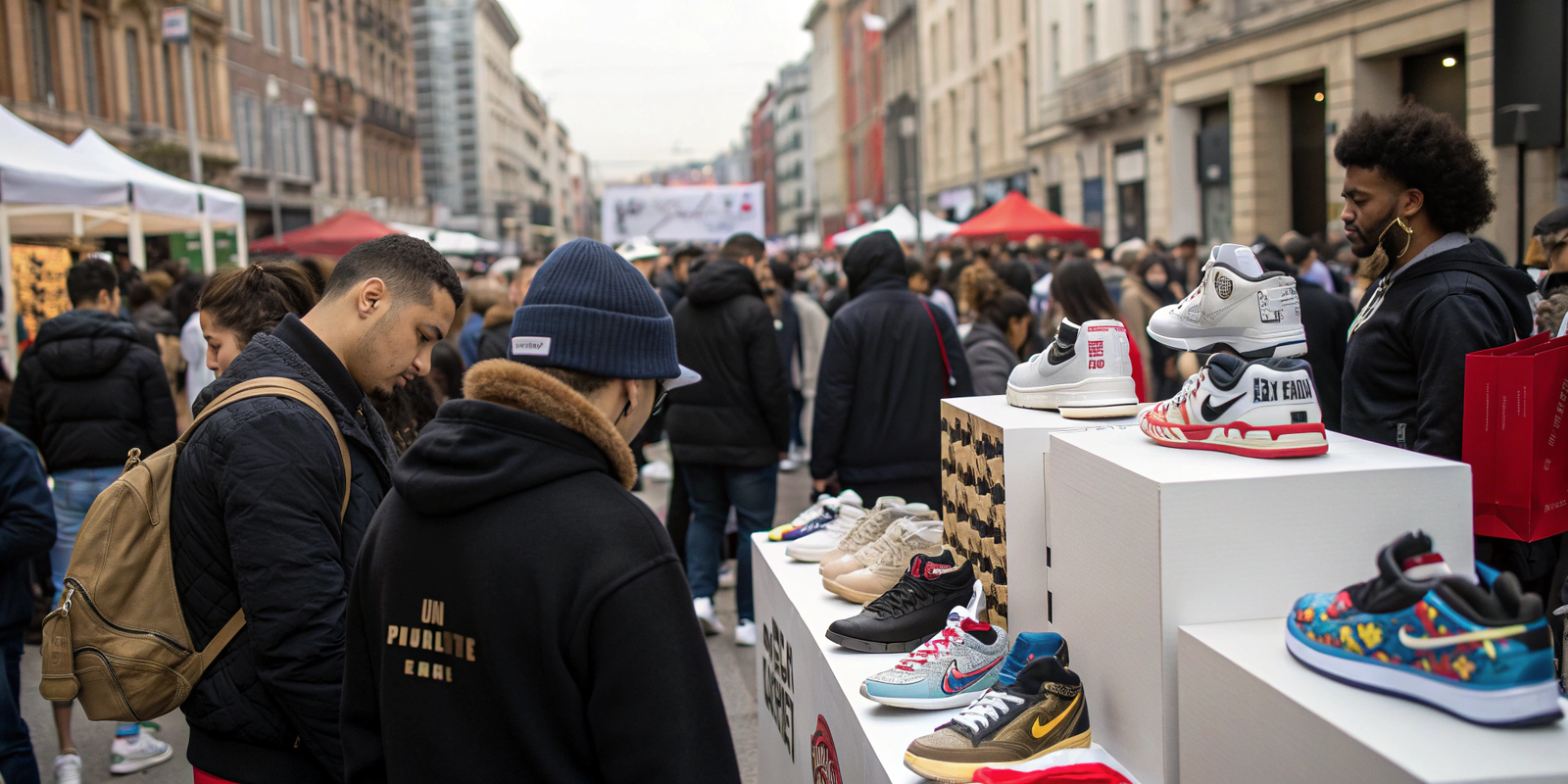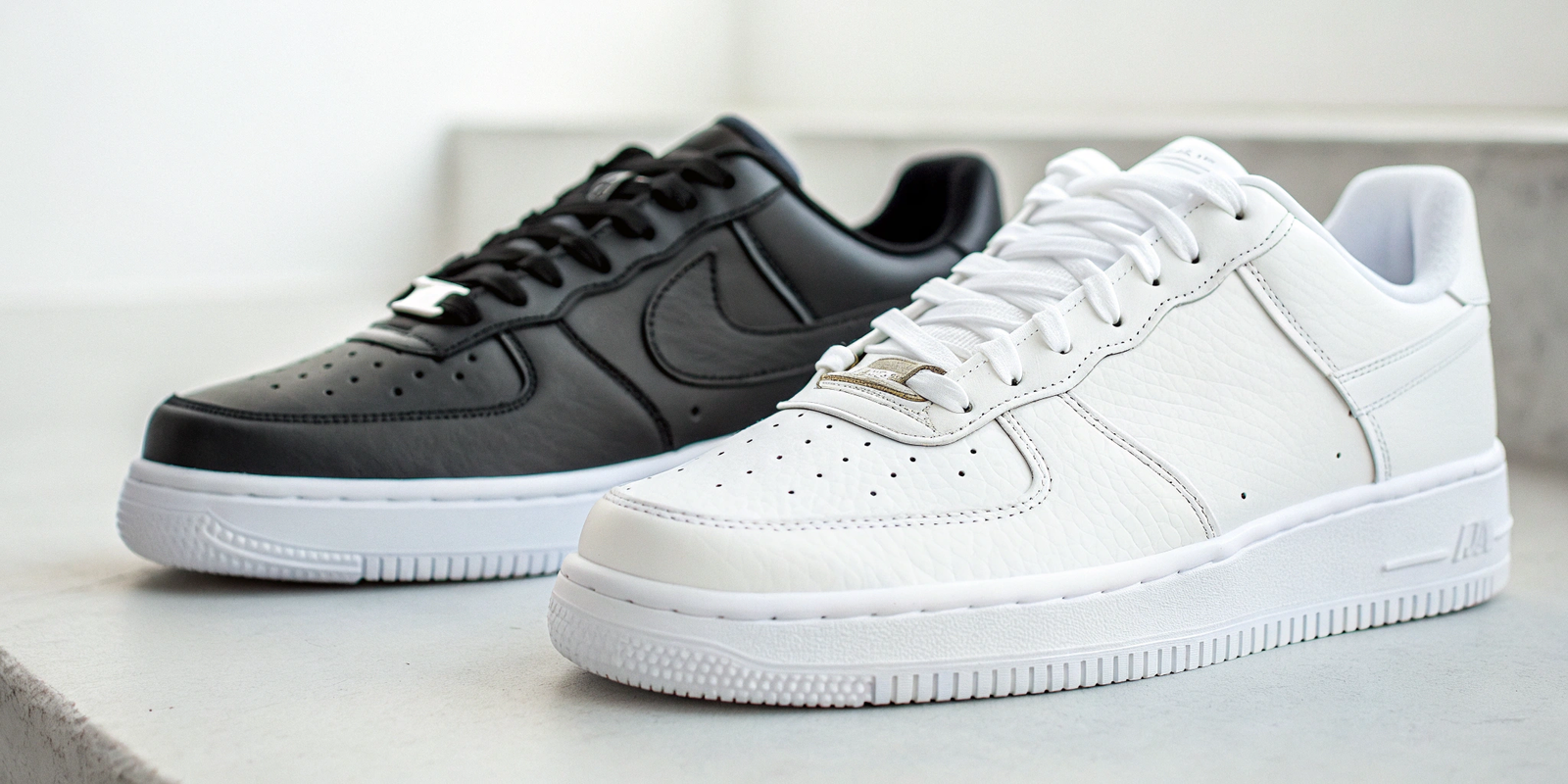Are you fascinated by the explosive growth of the sneaker resale market and wonder how it all works? It's a complex ecosystem.
The sneaker resale market, estimated to be worth billions, is a secondary marketplace where limited-edition and highly coveted sneakers are bought from primary retailers and then sold to consumers at significantly higher prices. This market thrives on exclusivity, hype, and cultural significance, allowing various players, from individual resellers to large platforms, to profit from the demand exceeding the original supply.
 As someone deeply involved in footwear manufacturing and market trends, I've seen firsthand how the industry has shifted. At Lucas, we focus on producing amazing shoes, but understanding the value chain beyond the factory floor, especially in resale, is crucial for grasping the full picture of the modern shoe business.
As someone deeply involved in footwear manufacturing and market trends, I've seen firsthand how the industry has shifted. At Lucas, we focus on producing amazing shoes, but understanding the value chain beyond the factory floor, especially in resale, is crucial for grasping the full picture of the modern shoe business.
Why do sneakers gain so much value after release?
Are you puzzled by how some sneakers, just moments after their retail release, skyrocket in value? It's a phenomenon driven by calculated market dynamics.
Sneakers gain significant value after release primarily due to artificial scarcity, brand collaboration hype, cultural influence from celebrity endorsements, and strategic marketing by brands. Limited supply coupled with high demand creates an immediate secondary market where collectors and enthusiasts are willing to pay a premium to acquire exclusive or culturally significant footwear that quickly sells out at retail.
 From my perspective at Lucas, it's a fascinating study in supply and demand. We make the shoes, but the perceived value is often carefully engineered by the brands long before they hit the market.
From my perspective at Lucas, it's a fascinating study in supply and demand. We make the shoes, but the perceived value is often carefully engineered by the brands long before they hit the market.
The Mechanics Behind Sneaker Value Appreciation
The rapid appreciation of sneaker values post-release is not random; it's a consequence of careful market manipulation and cultural trends.
- 1. Artificial Scarcity and Limited Editions:
- Brands like Nike and Adidas intentionally release specific models or colorways in very limited quantities. This creates immediate scarcity. When demand far outstrips supply, the market value naturally inflates. This strategy builds hype and makes the shoe more desirable because not everyone can get it.
- 2. Brand Collaborations and Storytelling:
- Collaborations with high-profile artists (e.g., Travis Scott), fashion designers (e.g., Virgil Abloh's Off-White), or iconic brands (e.g., Supreme, Louis Vuitton) elevate a sneaker's status. These collaborations often come with compelling stories or unique design elements that resonate deeply with consumers, turning the sneaker into a collector's item.
- 3. Celebrity Endorsements and Cultural Influence:
- When influential athletes, musicians, or pop culture figures wear a specific pair of sneakers, it instantly increases desirability. This "seen on" factor creates trends and validates the shoe's cultural relevance, prompting fans and fashion-conscious individuals to seek them out.
- 4. Strategic Marketing and "Hype" Generation:
- Brands meticulously plan their releases, often with cryptic teasers, countdowns, and staggered drops. This builds anticipation and a sense of urgency (FOMO - Fear Of Missing Out) among collectors. The media and sneaker blogs amplify this hype, further fueling demand.
- 5. The Collectible Nature and Investment Aspect:
- For many, rare sneakers are viewed less as mere shoes and more as collectibles or even alternative investments. Much like art or rare comics, their value can appreciate over time, encouraging a secondary market focused on speculation.
- 6. Online Retail and Botting:
- The primary release mechanism is often online, via raffles or "shock drops." This digital exclusivity makes it hard for individuals to secure pairs, as sophisticated "bots" are often used by resellers to quickly buy out available stock, pushing almost all pairs directly into the resale market at inflated prices.
These factors combine to transform a functional item of clothing into a highly sought-after commodity, whose value is determined less by its utility and more by its rarity, desirability, and cultural capital.
| Factor | Impact on Sneaker Value |
|---|---|
| Artificial Scarcity | Drives demand by limiting supply; triggers FOMO. |
| Brand Collaborations | Elevates status; adds unique storytelling/design. |
| Celebrity Influence | Creates trends; validates cultural relevance. |
| Strategic Marketing | Builds anticipation; fuels hype and urgency. |
| Collectibility | Turns sneakers into investment pieces; encourages speculation. |
| Online Release/Botting | Restricts access to primary market; pushes to inflated resale prices. |
Will the sneaker resale market crash or keep growing? Are you wondering about the future trajectory of the sneaker resale market? Its fate is a recurring debate among industry watchers. The sneaker resale market is likely to continue growing, albeit potentially with some volatility and maturity, rather than crashing entirely. While market saturation, changing consumer tastes, and increased brand intervention could temper growth, the underlying drivers of artificial scarcity, cultural influence, and consumer demand for exclusivity are strong enough to sustain its existence and expansion, adapting to new trends and technologies. In my long experience with footwear trends at Lucas, I've learned that markets rarely crash completely when based on strong cultural foundations. They evolve, and I expect the sneaker resale market to do the same.
The Trajectory of the Sneaker Resale Market: Growth or Volatility?
Predicting the exact future of any market is challenging, but several indicators suggest continued growth for the sneaker resale market, alongside potential for maturity and shifts.
- Arguments for Continued Growth:
- Persistent Demand for Exclusivity: As long as brands continue to employ scarcity as a marketing tool, there will be a robust secondary market for exclusive items. Consumers will always desire what is unique or hard to obtain.
- Growing Collectibility: The younger generations (Gen Z) are highly engaged with sneaker culture, viewing rare sneakers as legitimate collectibles and forms of self-expression. This cultural engagement shows no signs of waning.
- Expansion of Resale Platforms: The rise of sophisticated and trusted resale platforms (e.g., StockX, GOAT) has legitimized and streamlined the process, making it easier and safer for both buyers and sellers globally. These platforms continue to innovate and expand their reach.
- Globalization of Sneaker Culture: Sneaker culture is now a global phenomenon, with growing markets in Asia, Europe, and other regions, adding new demand pools.
- Brand Participation: Brands themselves are increasingly acknowledging and even participating in the resale market, either directly or through strategic partnerships. This legitimizes the market and could lead to new revenue streams for them, reducing the likelihood of them actively trying to "crash" it.
- Digital Innovation (NFTs, Metaverse): The integration of sneakers with digital assets (NFTs) and virtual worlds could open up new dimensions for collectible footwear, further extending the market's reach and value.
- Arguments for Potential Volatility/Maturity (but not a "Crash"):
- Market Saturation: As more players enter the market (both brands and individuals), competition for desirable releases could increase, potentially thinning profit margins for individual resellers.
- Brand Strategy Shifts: If brands decided to significantly increase production of popular models, or if they implemented more direct-to-consumer resale models, it could impact the traditional secondary market. However, completely abandoning scarcity seems unlikely given its success.
- Economic Downturns: Like any luxury or discretionary market, a significant global economic recession could impact consumer spending on high-priced collectible items, leading to a temporary slowdown or dip in values.
- Changing Consumer Tastes: Trends are cyclical. A shift away from "hype" culture towards more sustainable or accessible fashion could temper some of the extreme price growths, but is unlikely to dismantle the entire concept of limited-edition collecting.
In my view, rooted in the core of shoe manufacturing and market analysis, the sneaker resale market is more likely to mature and evolve, adapting to new challenges and opportunities, rather than collapse entirely. The underlying passion and demand for unique footwear are too strong.
| Factor | Impact on Resale Market Future |
|---|---|
| Demand for Exclusivity | Sustains market, drives desire for limited items. |
| Collectibility/Culture | Fuels ongoing youth engagement; reinforces value perception. |
| Resale Platforms | Legitimize and streamline transactions, expand accessibility. |
| Globalization | Adds new demand pools from emerging sneaker markets. |
| Brand Participation | Future integration could lead to evolution, not destruction. |
| Market Saturation | Could thin profit margins for some; increase competition. |
| Economic Downturns | Potential for temporary slowdowns or value dips. |
| Changing Tastes | Could shift foci of demand, but not eliminate market. |
How big is the sneaker resale market in 2025?
Are you trying to gauge the sheer scale of the sneaker resale market, specifically looking ahead to 2025? The numbers are impressive.
While exact figures constantly fluctuate, the global sneaker resale market is projected to reach approximately $30 billion by 2030, suggesting it could be well over $10 billion to $15 billion in 2025. This growth is driven by increasing demand for limited-edition sneakers, the expansion of global sneaker culture, and the continued professionalization and legitimization of dedicated resale platforms.
 Working in shoe manufacturing at Lucas, we see the raw materials and the assembly line. But the aftermarket value creation is a whole different beast, and its size indicates a powerful economic force.
Working in shoe manufacturing at Lucas, we see the raw materials and the assembly line. But the aftermarket value creation is a whole different beast, and its size indicates a powerful economic force.
The Scale of the Sneaker Resale Market
Estimating the exact size of a secondary market like sneaker resale can be challenging due to its dynamic nature and the mix of formal and informal transactions. However, various financial reports and industry analyses provide strong projections for its growth.
- Current Estimates and Projections:
- As of late 2023, the global sneaker resale market was commonly estimated to be between $6 billion and $10 billion annually.
- Leading financial institutions and market research firms, such as Cowen Investment Bank, have projected the market to reach $30 billion globally by 2030.
- Using this projection, a linear or slightly accelerated growth curve from 2023 to 2030 would place the market size in 2025 likely in the range of $10 billion to $15 billion. This represents a significant and rapidly growing segment of the broader footwear industry.
- Key Drivers of Market Growth:
- Digitization of Resale: Platforms like StockX, GOAT, and Stadium Goods have standardized and secured transactions, making it easier and safer for millions of people to participate. Their data collection also allows for more accurate market sizing.
- Global Reach: Sneaker culture has expanded exponentially beyond its traditional Western strongholds, with booming markets in Asia (especially China and Japan), Europe, and the Middle East, all contributing to the demand for limited releases.
- Investor Interest: The market has attracted attention from investors who view rare sneakers as alternative assets within their portfolios, further validating its economic significance.
- Brand Engagement: Brands are no longer ignoring the resale market; some are actively studying its dynamics for insights into consumer demand and brand value. This tacit acknowledgment further legitimizes its size and growth.
- Cultural Embeddedness: For younger generations, sneakers are a core part of identity and fashion. The pursuit of highly sought-after pairs is a significant cultural activity, underpinning continued market activity.
The sheer volume of transactions and the increasing average resale price for many rare models contribute to these impressive valuation figures. The sneaker resale market is not just a niche hobby; it's a multi-billion dollar industry that significantly impacts the broader fashion and retail landscape.
| Year (Estimate) | Projected Market Size (Global) | Driving Factors |
|---|---|---|
| 2023 | $6 Billion - $10 Billion | Growing awareness, platform maturity, initial post-pandemic boom. |
| 2025 (Projected) | $10 Billion - $15 Billion | Continued platform expansion, globalization, increasing brand interest. |
| 2030 (Projected) | Target of $30 Billion | Full market maturity, potential for new digital integrations (NFTs), sustained cultural importance. |
Who profits the most from sneaker reselling?
Are you curious about where the money goes in the billion-dollar sneaker resale market? Many players are involved.
The primary profiting parties in sneaker reselling are the large resale platforms (e.g., StockX, GOAT) through commissions and fees, followed by individual power resellers and organized reseller groups who leverage automation and scale to acquire and flip large volumes. Brands benefit indirectly from the immense hype and increased brand value generated by the scarcity and high resale demand of their products, even if they don't directly participate in the secondary sales.
From my vantage point in shoe manufacturing at Lucas, we see the raw material cost and our production margins. But the journey from our factory to a buyer's hand in resale involves many more hands, each taking a cut.
The Beneficiaries of the Sneaker Resale Ecosystem
The profits generated in the sneaker resale market are distributed among several key stakeholders, each playing a different role.
- 1. Resale Platforms (The Biggest Winners):
- StockX, GOAT, Stadium Goods, Flight Club: These platforms are arguably the biggest beneficiaries. They operate as marketplaces, connecting buyers and sellers. Their profit comes from:
- Transaction Fees/Commissions: A percentage of every sale (typically 9-12% for sellers, plus a processing fee for buyers).
- Authentication Fees: Charging for verifying the authenticity of each shoe, which is crucial for buyer trust.
- Shipping Fees: Managing logistics and charging for it.
- Data and Analytics: Leveraging their vast sales data to provide market insights, sometimes even selling this data.
- These companies process millions of transactions annually, giving them a significant revenue stream with relatively low inventory risk compared to traditional retailers.
- StockX, GOAT, Stadium Goods, Flight Club: These platforms are arguably the biggest beneficiaries. They operate as marketplaces, connecting buyers and sellers. Their profit comes from:
- 2. Individual Power Resellers and Reseller Groups:
- These are the individuals or organized teams who actively acquire sneakers at retail price and then flip them on the secondary market. They profit from the price difference between the retail cost and the resale value, minus platform fees.
- Methods of Profit: They often invest significant time and some capital in acquiring shoes, using automated bots, multiple accounts, and sophisticated strategies to secure limited releases. Their profit depends on the volume of shoes they can secure and the margin on each pair.
- 3. Brands (Indirectly, but Significantly):
- Nike, Adidas, Jordan Brand, etc.: While brands don't directly profit from secondary market sales, they benefit immensely in indirect ways:
- Increased Hype and Brand Desirability: The resale market generates massive buzz and demand for their limited products, making their brands more aspirational and coveted.
- Marketing at No Cost: The constant discussion, news, and social media activity around highly sought-after releases act as free, global marketing.
- Justification for Higher Retail Price: The high resale value can sometimes justify higher retail prices for future releases.
- Demand Forecasting: Resale data can provide valuable insights into actual consumer demand for certain styles or collaborations.
- Nike, Adidas, Jordan Brand, etc.: While brands don't directly profit from secondary market sales, they benefit immensely in indirect ways:
- 4. Authenticator Services:
- Companies that specialize solely in authenticating sneakers (sometimes third-party to the platforms) profit from ensuring the legitimacy of high-value sneakers.
- 5. Individual Casual Resellers:
- These are individuals who might buy a few pairs speculatively or just happen to get lucky on a release. They make smaller, less consistent profits compared to power resellers, but contribute to the market's liquidity.
In essence, the entire ecosystem thrives on the initial scarcity created by the brands, with platforms providing the infrastructure for safe transactions, and professional resellers capitalizing on the demand.
| Beneficiary | How They Profit |
|---|---|
| Resale Platforms | Commissions, transaction fees, authentication fees; low inventory risk. |
| Power Resellers/Groups | Buying at retail, flipping at higher resale prices; volume-driven. |
| Brands (Indirectly) | Increased hype, free marketing, enhanced brand desirability/value. |
| Authenticator Services | Fees for verifying product legitimacy. |
| Casual Resellers | Occasional profits from lucky retail buys. |
Conclusion The sneaker resale market, projected to reach over $10 billion by 2025, is driven by artificial scarcity, cultural hype, and brand collaborations, leading to significant value appreciation post-release. While individual power resellers profit from flipping, the major beneficiaries are the large resale platforms. The market is expected to continue growing and evolving rather than crashing, fueled by persistent demand for exclusivity and global sneaker culture.
